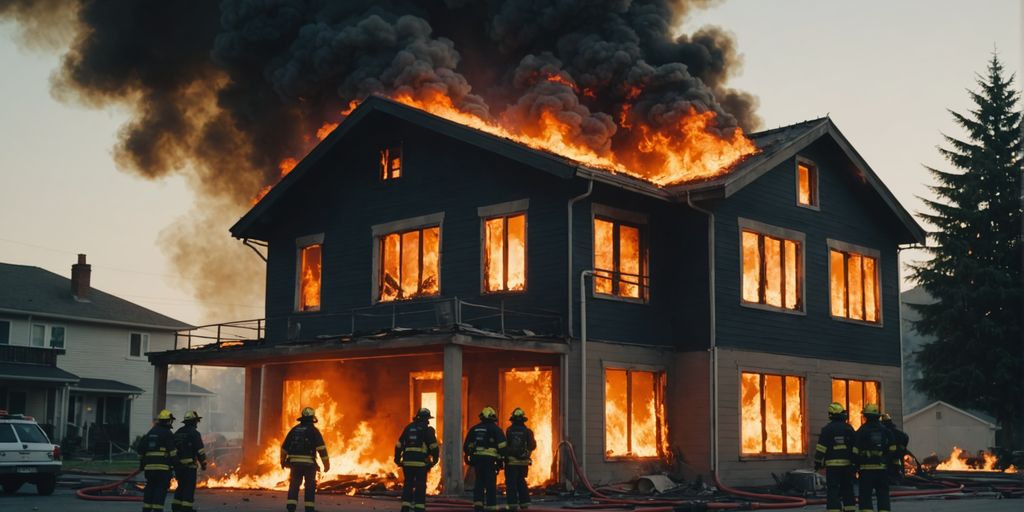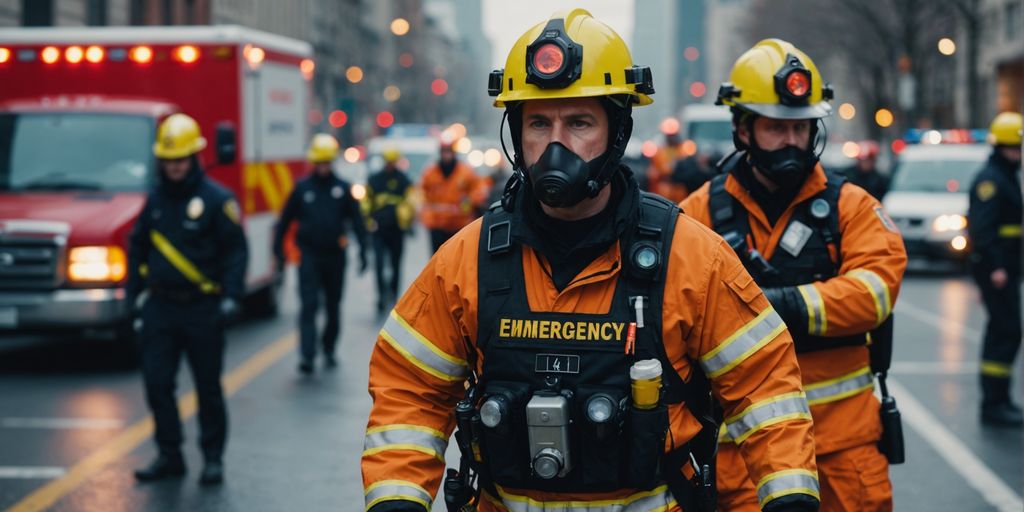House fires can happen unexpectedly and have serious consequences. They can destroy property and put lives at risk. Knowing how to prevent fires and what to do if one happens can make a big difference. This guide will help you understand common fire hazards, how to install and maintain smoke detectors, create a family escape plan, and more.
Key Takeaways
- Understand the main causes of house fires, such as electrical problems, cooking accidents, and heating equipment issues.
- Install smoke detectors in the right places and check them regularly to make sure they work.
- Create a fire escape plan for your family, including escape routes and a meeting spot outside.
- Know how to use and take care of fire extinguishers, and make sure they are inspected regularly.
- Teach children about fire safety and keep matches and lighters out of their reach.
Understanding Common Causes of House Fires
House fires can have devastating consequences, but understanding their common causes can help prevent them. Identifying and addressing potential fire hazards is the first step in creating a fire-safe home.
Installing and Maintaining Smoke Detectors
Smoke detectors are essential for fire safety, providing early warnings that can save lives. Installing smoke detectors on every level of your home and in each bedroom is crucial. Regular maintenance ensures they function correctly when needed most.
Creating a Family Fire Escape Plan
Preparing your family for potential fire emergencies is essential to ensure their safety and swift evacuation. Develop a comprehensive fire escape plan that includes the following elements:
Proper Use and Maintenance of Fire Extinguishers
Fire extinguishers are essential tools for combating small fires before they spread. Choosing the right type of fire extinguisher is crucial for effectively handling different fire hazards. For home use, ABC fire extinguishers are the most versatile, as they can handle fires involving ordinary combustibles, flammable liquids, and electrical equipment.
Types of Fire Extinguishers
There are several types of fire extinguishers, each designed for specific types of fires:
- Class A: For ordinary combustibles like wood and paper.
- Class B: For flammable liquids such as grease, gasoline, and oil.
- Class C: For electrical equipment fires.
- Class ABC: Multipurpose extinguishers suitable for Class A, B, and C fires.
How to Use a Fire Extinguisher
Knowing how to use a fire extinguisher can save lives. Remember the acronym “PASS”:
- Pull the pin.
- Aim at the base of the fire.
- Squeeze the handle.
- Sweep from side to side.
Regular Inspections
[[Regular maintenance](https://www.securitas.uk.com/Blogs/how-to-use-fire-extinguishers-correctly/) is crucial](https://csafire.com/a-business-owners-guide-to-commercial-fire-extinguishers-types-and-uses/) to ensure your fire extinguisher works when needed. Monthly inspections and annual professional checks are recommended. This ensures the extinguisher is in good working condition and ready for use in an emergency.
Maintenance Tips
- Check the pressure gauge monthly to ensure it is in the green zone.
- Inspect the extinguisher for any visible damage or corrosion.
- Ensure the nozzle is clear and unobstructed.
- Replace the extinguisher if it is damaged or has been used.
By following these guidelines, you can ensure your fire extinguisher is always ready to protect you and your home.
Fire Safety in the Kitchen
Kitchens are a common area where fires can start. Never leave cooking unattended, especially when using the stove or oven. Keep flammable items like kitchen towels, potholders, and curtains away from heat sources. In case of a stovetop fire, turn off the burner and cover the pan with a lid or a metal baking sheet. For oven fires, keep the door closed and turn off the heat. Use a fire extinguisher if the fire is small and manageable. Brands like Amerex and Kidde offer reliable kitchen fire extinguishers.
Childproofing Your Home Against Fire Hazards
Childproofing your home is crucial to minimize fire risks, especially for families with young children. Install safety gates to keep children away from dangerous areas like the kitchen or fireplace. Here are some key steps to ensure your home is safe:
Securing Matches and Lighters
Always keep matches, lighters, and other flammable materials out of children’s reach. Store them in high cabinets or locked drawers. Educate your children about the dangers of playing with these items.
Using Childproof Outlets
Install childproof outlet covers to prevent children from inserting objects into electrical outlets. This simple step can prevent electrical fires and keep your little ones safe.
Educating Children on Fire Safety
Teach your children about fire safety from an early age. Explain the importance of staying away from open flames and what to do in case of a fire. Regularly practice fire drills so they know how to respond in an emergency.
Safe Handling and Storage of Flammable Materials
Homeowners should understand how to safely handle and store flammable materials to prevent accidents. Store gasoline, kerosene, and other flammable liquids in approved containers in a cool, well-ventilated area away from living spaces. Invest in safety cabinets or containers like the Justrite Safety Can, ranging from $30 to $100, for secure storage.
Fire Safety for Electrical Systems
Electrical fires can be prevented with the right precautions. Schedule regular inspections by a licensed electrician to find and fix any faulty wiring or overloaded circuits. Never overload electrical outlets with multiple appliances using extension cords or power strips. Replace damaged cords or plugs immediately and ensure that all outlets have proper cover plates.
Avoiding Overloaded Circuits
Overloading circuits is a common cause of electrical fires. To avoid this, do not plug too many devices into a single outlet. Use power strips with built-in circuit breakers and avoid daisy-chaining multiple power strips together.
Regular Electrical Inspections
Having a certified electrician inspect your electrical system periodically is crucial. They can identify potential hazards like frayed wires or outdated components that need replacing. This proactive approach helps in maintaining a safe living environment.
Safe Use of Extension Cords
Extension cords should be used sparingly and only as a temporary solution. Make sure they are in good condition and not frayed or damaged. Never run extension cords under rugs or furniture, as this can cause them to overheat and potentially start a fire.
Heating Equipment Safety Tips
Heating equipment is one of the leading causes of home fires, especially during the winter months. With a few simple safety tips and precautions, you can prevent most heating fires.
Garage Fire Safety Measures
Garages often store various flammable materials, making fire safety paramount. Implementing these fire prevention measures significantly enhances the safety of homeowners’ households and allows them to protect their loved ones and property from the devastating effects of fires.
Responding to a Fire Emergency
Evacuating Safely
When a fire breaks out, your first priority should be to get out and stay out. Yell "Fire!" several times to alert others and head outside immediately. If you live in a building with elevators, use the stairs instead. Leave your belongings behind and focus on your safety. If you encounter a closed door, feel it with the back of your hand. If it’s warm or if smoke is blocking your main escape route, use your second way out. Never open doors that are warm to the touch.
Calling Emergency Services
Once you are safely outside, call 9-1-1 or your local emergency number. Provide them with your location and any important details about the fire. Do not re-enter the building for any reason until the authorities have declared it safe to do so.
What to Do After a Fire
After the fire has been extinguished, it’s important to stay informed and follow the instructions of emergency personnel. They will let you know when it is safe to re-enter your home. Be aware that emergency response could be delayed or impossible in some situations. Turn on lights to help rescuers find you if you are trapped. Evaluate your home for any remaining hazards and take steps to reduce or eliminate them. This can help you stay safe and may also help control insurance costs.
Conclusion
In conclusion, fire safety is a crucial aspect of home life that should never be overlooked. By taking simple steps like installing smoke detectors, keeping fire extinguishers handy, and educating your family on fire response techniques, you can greatly reduce the risk of a fire in your home. Remember, being prepared and vigilant can make all the difference in protecting your loved ones and your property. Stay safe and make fire prevention a priority in your household.


